Pictures 1980s
|
|
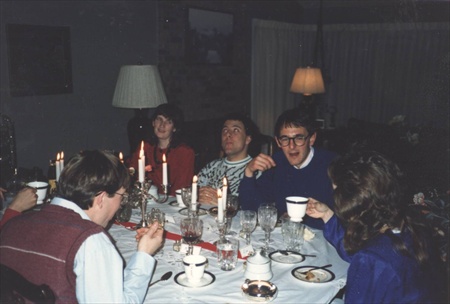
November 25, 1989
From left clockwise: Mike Wellons, Helen Wellons, Steve Lustig,
Jerôme van Straaten and Lisa Brannon-Peppas. Mike and Helen
Wellons worked with Professor Reklaitis and are now with ExxonMobil.
Jerôme van Straaten spent a year as a visiting scientist working
on protein adsorption on polymeric surfaces for non-thrombogenic
applications. His work was extremely well cited. He is now with
C.F.P.O. in Venissieux, France. Steve Lustig has had a brilliant
research career at duPont where he is now one of their most
imaginative and published researchers.
|
| |
|
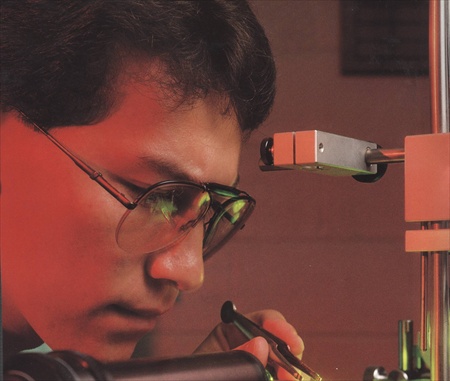
March 1989
Jorge Olivares (MS ’90) working with a goniometer. Jorge had
the distinction of being the last graduate student who worked
on coal research. Yet, his professional career was in the biomedical
field, with Eli Lilly in Lafayette, IN.
|
| |
|
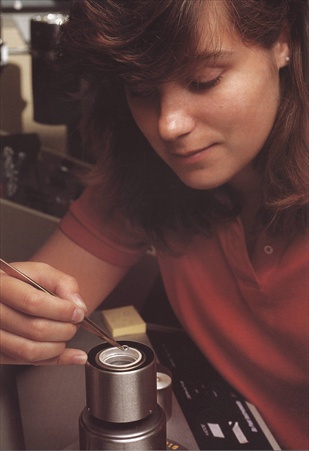
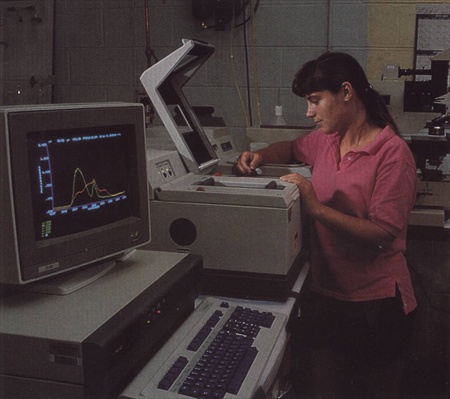
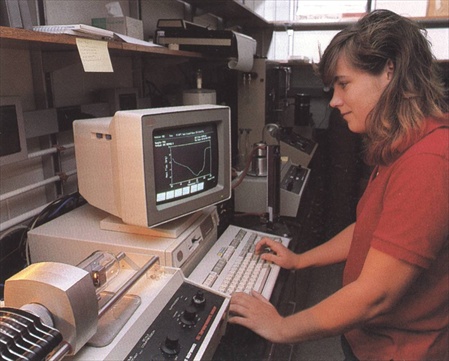
March 1989
Jennifer Sahlin (MS ’89, PhD ’92) working on a 1990s vintage
Nicolet FTIR spectrophotometer. Jennifer was an important contributor
to the group. In her MS thesis she developed the well-known
relaxational/diffusional heuristic model that led to a new method
of analysis of drug transport in swellable polymers. This work
was published in IJP and has received more than 350 citations.
Jennifer is now a manager with 3M in St Paul, MN. In her PhD
she used ATR-FTIR studies to prove the interpenetration of compatible
polymer layers by diffusion. A nice proof of deGennes interdigitation
theory, this work led, among others, to our understanding of
mucoadhesion by interpenetration.
|
| |
|
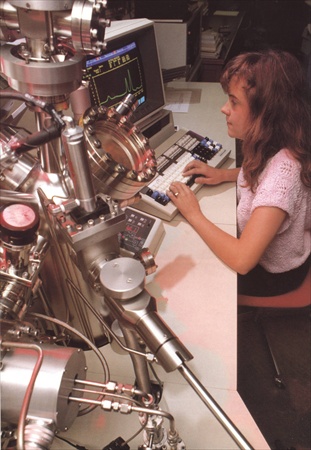
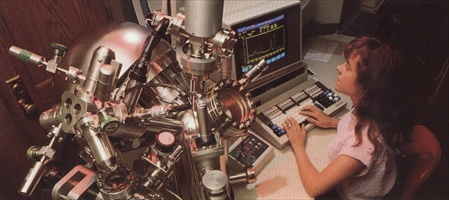
February 1989
Lyn Eshelmann (BS ’87, PhD ’92) now with Eastman Kodak in Rochester,
NY. Lyn worked with Tony Mikos on new methods for hydrophilic
polymer particle production. Later she was a PhD student in
Dr Nick Delgass’ laboratory. She is now with Eastman Kodak in
Rochester, NY.
|
| |
|
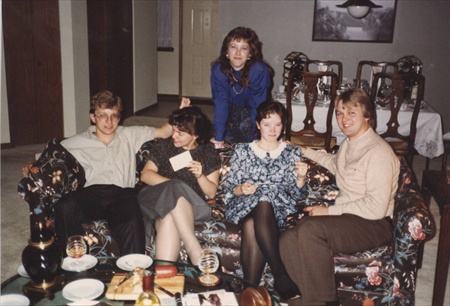
December 1988
From left: John Klier (now with Dow Chemical), Nancy Loiacono-Klier,
Lisa Brannon-Peppas, Lisa Scranton, Alec Scranton (now Assoc
Dean of Engineering at the Univ of Iowa)
|
| |
|
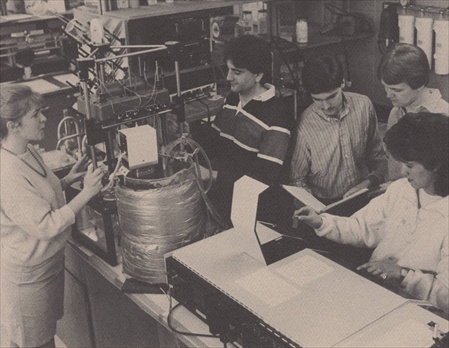
March 1988
Michelle Knight-Bridgewater (BS ’89, now in Akron, OH), Ron
Harland, Rick Drummond (BS ’89, now with Nabisco in NJ), Alec
Scranton and Lori Keneipp-Schrad (BS ’89) at the diffusion apparatus
and the old UV spectrophotometer. Michelle Knight and Rick Drummond
discovered an important oscillatory effect of the swelling behavior
in pH-sensitive materials.
|
| |
|
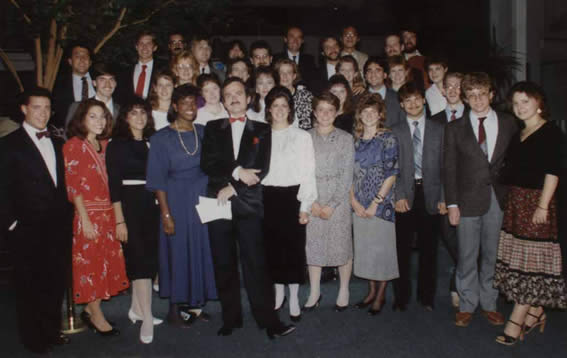
October 16, 1987
In just ten years after its establishment, the lab was a beehive
of scientific activity with more than 30 researchers. For some
reason, this 1987 picture from a major lab dinner at the atrium
of the Hyatt Hotel in West Lafayette, IN, has been used by former
students in their presentations. This is known also the photograph
of twelve future professors!
First Row: Waleed Shalaby, Jessica Alameda, Rashmi Drummond,
Lynette Malone,
NAP, Lori Keneipp, Dawn Edwards, Sandra Shoup, Chris Bowman,
Curt Walker, John Kler, Nancy Loiacono-Klier
Second Row: Rich Drummond, Cathy Blinstrub, Jennifer Broadbelt-Lustig,
Lisa
Scranton, Tiziana Canal, Lisa Brannon, Mara Lovrecich, Dee Ann
Harland, Amy
Carver, Ron Harland, Shari Kennett, Jennifer Sahlin
Third Row: Steve Lustig, Greg Schard, husband of S. Feigen,
Alec Scranton,
S. Feigen, Tony Mikos, Prof. Paolo Colombo of the Univ. of Parma,
Ray Muleskey,
Any Tsou, Shari Kennett's friend, Humphrey Moynihan
|
| |
|
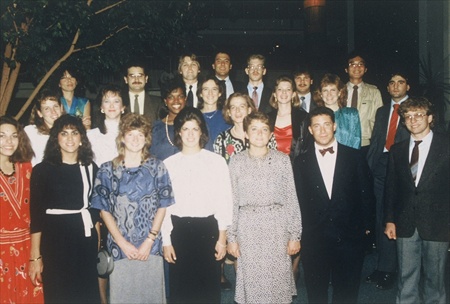
October 1987
First Row: Jessica Alameda, Rashmi Drummond, Sandra Shoup, Lori
Keneipp, Dawn Edwards, Waleed Shalaby, John Klier Second row:
Kathy Blinstrub, Lisa Brannon-Peppas, Lynette Malone, Tiziana
Canal, Mara Lovrecich, Amy Carver, Shari Kennett, Ron Harland
Third row: S. Feigen, Tony Mikos, Alec Scranton, Steve Lustig,
Curt Walker, Chris Bowman, Andy Tsou. Andy Tsou, presently with
Eastman Kodak, has the distinction of being the student who
did the fastest PhD in the history of the lab, graduating in
just 2 years and 8 months (he had a MS from Penn State). Almost
twenty years later, Brock Thomas finished his PhD at UT in 2
years and 9 months after a BS from the University of Tennessee.
|
| |
|
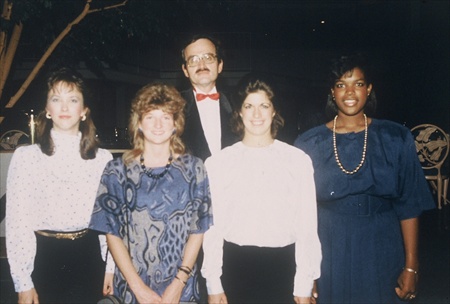
October 1987
Lisa Brannon-Peppas, Sandra Shoup, Lori Keneipp and Lynette
Malone with Prof. Peppas. This team addressed important, early
research on essential oil delivery in cosmetic, consumer and
food products.
|
| |
|
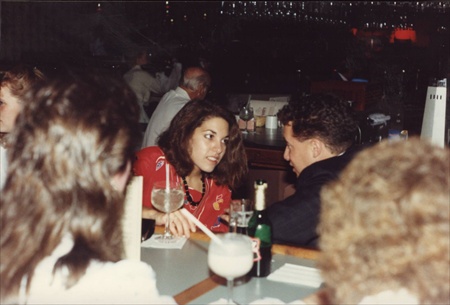
October 1987
Two future physicians talk about their future plans, while still
seniors in Chemical Engineering at Purdue University. Jessica
Alameda (now Guingrich, Professor of Medicine at the University
of Illinois in Peoria) and Waleed Shalaby (Director, Division
of Maternal-Fetal Medicine at the Riverside Healthcare Center
in Wilmington, Delaware). Jessica studied at the University
of Illinois Medical School. Waleed did first his PhD in the
Pharmacy Department at Purdue with Kinam Park. At that time
he published a highly successful book on biodegradable hydrogels.
He did his MD at the University of Pennsylvania
|
| |
|
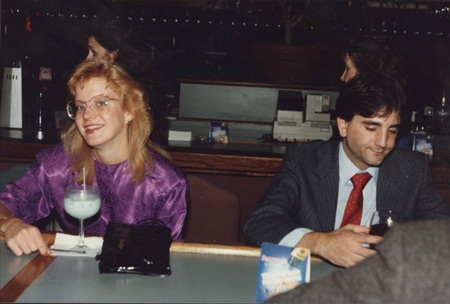
October 1987
Our colleague and collaborator at the University of Texas, Jennifer
Brodbelt (now Professor of Chemistry) was a graduate student
in Chemistry at Purdue working with Professor Graham Cooks (PhD
’89). To her left Ron Harland (MS ’85, PhD ’88, now CEO of PharmSolv
LLC in Yardley, PA)
|
| |
|
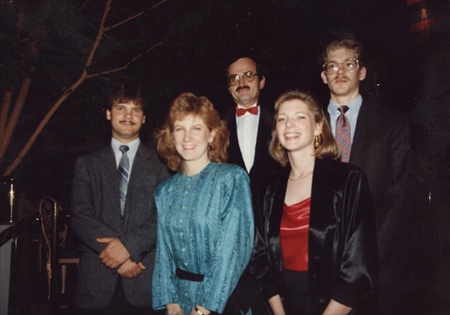
October 1987
From left: Chris Bowman (BS ’88, PhD ’91, now Associate Dean
of Engineering at the University of Colorado), Shari Kennett
(BS ’88, now with Dow Chemicals Co.), Nicholas Peppas, Amy Curver-Mulesky
(BS ’88, now with Bristol-Myers Squibb) and C. Michael Walker
(BS ’88). They are shown here as seniors in Chemical Engineering.
These four students (all doing honors (BS) theses at that time)
created a formidable research team that studied fast polymerization
reactions leading to information storage systems
|
| |
|
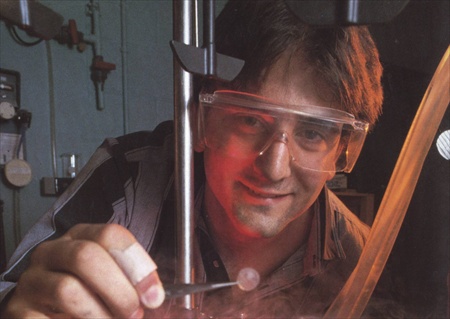
October 1987
Ron Harland (MS ’85, PhD ’88) performing drug delivery studies
with a USP dissolution apparatus (October 1987). Ron did valuable
research on controlled release from semicrystalline polymers
and developed important models for diffusion in composites.
Among other things, Ron was the co-author of the 1987 History
of ChE at Purdue University. Just fresh from their PhDs, Ron
and Lisa Brannon-Peppas wrote an Elsevier book on "Superabsorbent
Polymer Technology". This 1989 work became the leading book
in the field.
|
| |
|
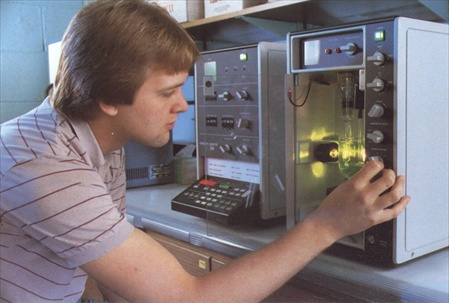
September 1987
Alec Scranton (now Associate Dean of Engineering at the University
of Iowa, PhD ’88) investigates the particle size distribution
of hydrophilic polymer samples using a Coulter counter (September
1987). Alec was only the second PhD student to work on polymerization
reaction engineering. The distinguished list of students who
worked on polymerization reaction engineering started with Tony
Mikos in 1983 (MS thesis) and continued with Alec Scranton,
Andy Tsou (PhD ’87), Chris Bowman (PhD ’90), Eric Dietz (PhD
’94), Dev Kurdikar (PhD ’94), Rob Scott (PhD ’98), Jenny Harting-Ward
(2000) and David Henthorn (BS ‘2003). The work was supported
for almost 20 years by the National Science Foundation.
|
| |
|
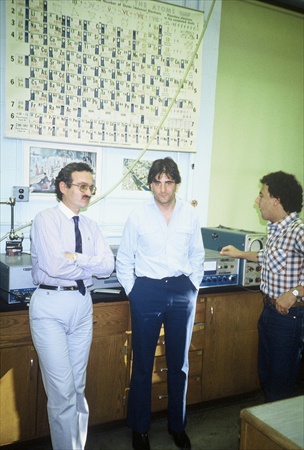
May 1987
Nicholas Peppas, Ron Harland and Steve Lustig. The table of
elements on the lab wall has some historical significance. When
we opened the Purdue labs in September 1976, Todd Gehr insisted
that there could be no lab without this table. And so, this
was the very first item ordered in the lab...along with a Mettler
balance that we still have in the lab.
|
| |
|
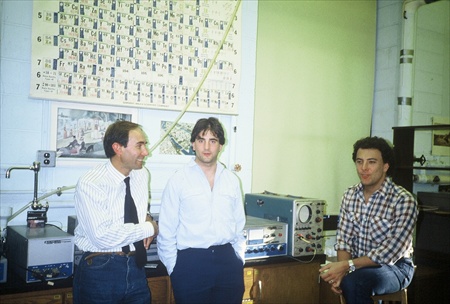
May 1987
Prof Paolo Colombo of the University of Parma, Italy, Ron Harland
and Steve Lustig. A 25 year long friendship with Paolo Colombo
has benefited both laboratories not only in operatic activities
(!) but also in scientific exchanges. Purdue and UT lab students
who worked in Prof Colombo's laboratories have included Chris
Brazel, Surya Mallapragada, Balaji Narasimhan, Ron Harland,
Kristi Anseth, Tony Lowman while Italian students in our laboratories
have included Didi Sangalli (now professor at the University
of Milan), Paolo Giunchedi (now professor at the University
of Sassari), Lauretta Maggi (now professor at the University
of Pavia), Ruggero Bettini (now professor at the University
of Parma), Alessia deAscentiis, Maria Teresa Peracchia (now
at Sanofi-Aventis in Paris), Cristina Donini (now at Merck-Serono
in Geneva, Switzerland), Elena Losi, and Gaia Colombo (now lecturer
at the University of Ferrara).
|
| |
|
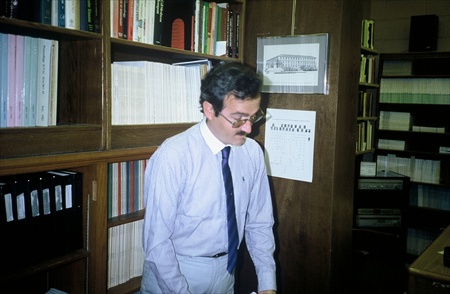
January 1987
Professor Peppas in early January 1987 after his return from
his sabbatical at the University of Paris-Sud. The obvious metamorphosis
over the 1985 and 1986 pictures below took place in six months,
during sabbatical in Paris (!) and under doctor's strict orders...
|
| |
|
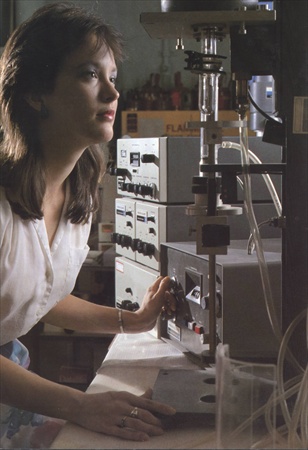
November 1986
Lisa Brannon (MS ’86, PhD ’88) runs a thermogravimetric analysis
apparatus. Lisa’s PhD was the first major effort of the lab
to use pH-sensitive hydrogels in drug delivery. She developed
the successful “Brannon-Peppas model” of swelling behavior of
ionic hydrogels and published some pioneering and highly cited
work in the field (November 1986). Lisa was also the earliest
student to work with pH-sensitive hydrogels in drug delivery.
After three years at Eli Lilly, Lisa started Biogel Technology
of Indianapolis, a company specializing in chemotherapeutic
drug delivery (1991-2002). She is presently a professor of Biomedical
Engineering at the University of Texas, Austin.
|
| |
|
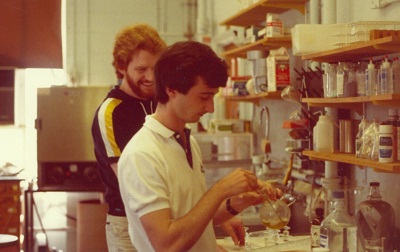
March 1986
John Howell (left, BS Chem ’83) and Serge Segot-Chicq (visiting scientist in 1986 and later DEA ’87 from the University of Paris-Sud under Peppas’ supervision).
|
| |
|
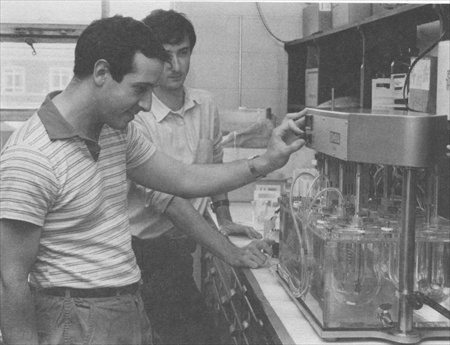
March 1986
Eric Teillaud and Serge Segot-Chicq run early dissolution studies
using a US Pharmacopoieia procedure. Collaboration with French
researchers started in 1982. Eric Teillaud was an employee of
the company Laboratoires Fournier in Chenôve, France when he
started driving to Geneva, Switzerland to take Professor Peppas’
class on drug delivery in the Fall 1982. As a result of this
interaction, Eric Teillaud came to our laboratory in 1985-86
and worked as a visiting scientist on drug delivery systems.
He is now Head of Pharmaceutical Development at Merck Santé,
in Lyon, France. Serge Segot-Chicq was a student of Professor
Francis Puisieux at he University of Paris-Sud when he came
to Purdue to work as a visiting scientist and get his DEA. He
worked on novel swellable systems based on ethylene vinyl alcohol
copolymers. He is now manager at Sanofi-Aventis in Paris, France.
|
| |
|
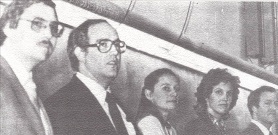
November 20, 1985
From left: Bill Padgett (BS ’78), Tom Padgett (BS ’78), Teri
Nagel-Carter (BS ’81), Carol Saunders-Harbaugh (BS ’80, now
with ExxonMobil) and Steve Padgett (BS ’78, now with East man
Kodak) speaking about professional guidance on November 20,
1985. The last three were important contributors to research
in our laboratories. Carol Saunders worked on poly(vinyl alcohol)
membranes while Steve Padgett (along with Katie Holbeck-Patterson
(BS ’78)) was instrumental in analyzing the three-dimensional
structure of semicrystalline, plasticized poly(vinyl chloride).
This work that was published in 1979 showed that it was possible
to use Flory rubber elasticity theories to determine the distance
between microcrystallites in slightly crystalline polymers.
|
| |
|
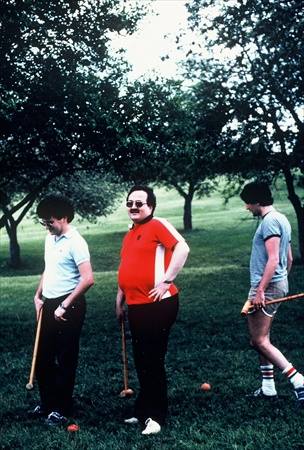
May 1985
A candid shot from the second
Annual Croquet Game
of the laboratory with Tony Mikos (left) and Ron Harland (right),
two formidable competitors. Tony is now a distinguished professor
of Biomedical and Chemical Engineering at Rice University, while
Ron is President of PharmSolv LLC.
|
| |
|
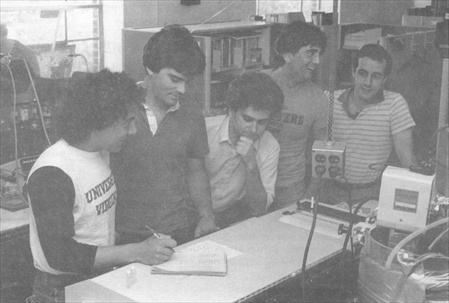
April 1985
Steve Lustig (MS ’85, PhD ’89), Kent Urdahl (MS ’85), Tony Mikos
(MS ’85, PhD ’88), Ron Harland (BS '83, MS '85, PhD '88) and
Eric Teillaud (visiting scientist ’85-86)
|
| |
|
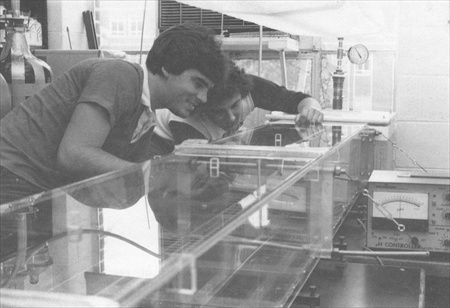
March 1985
Kent Urdahl (MS ’85) and Steve Lustig (MS ’85, PhD ’89) at the
large laminar flow channel of Professor Neal Houze. Kent and
Steve contributed significantly to our understanding of penetrant
transport in glassy polymers. Kent Urdahl was any early contributor
of advanced micrographic studies of cracking and crazing in
glassy polymers. His work on penetrant overshoots due to crosslinking
is classic. Steve Lustig developed probably the most advanced
and molecularly accurate viscoelastic model for non-Fickian
transport.
|
| |
|
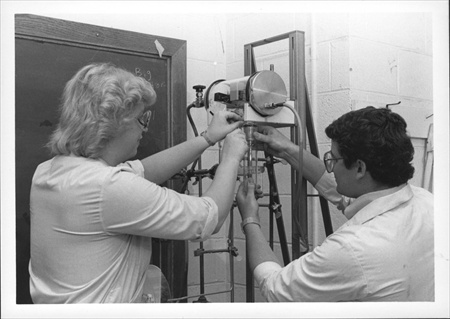
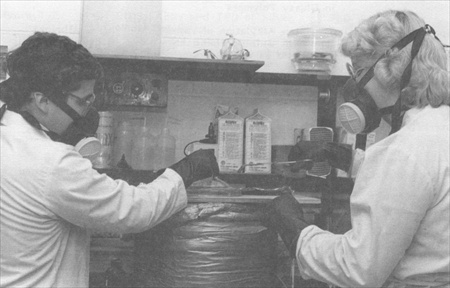
February 1985
Barbara Barr-Howell (BS ’82, MS ’85) and Phil Ritger (MS ’85)
operate a Cahn microbalance and perform nasty swelling studies
of bituminous coals in pyridine. Phil Ritger developed the general
transport theory in glassy polymers for coals. Yet, this work
was applied also in drug delivery. The well-known Ritger-Peppas
theory was published in two papers in the Journal of Controlled
Release in 1987. One of these papers became the most cited paper
in JCR’s history. It must be noted that the exponential form
of the equation was first developed by Richard Korsmeyer and
Nicholas Peppas as early as 1981, although it was Phil Ritger
who provided the detailed analysis for all geometries.
|
| |
|
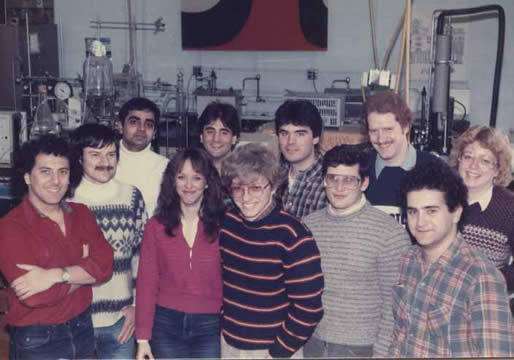
December 1984
First Row: Steve Lustig, Christian Bindshaedler, Lisa Brannon,
John Klier, Phil Ritger, Tony Mikos
Second Row: Narsi Sundaram, Ron Harland, Kent Urdahl, John Howell,
Barbara Barr-Howell
|
| |
|
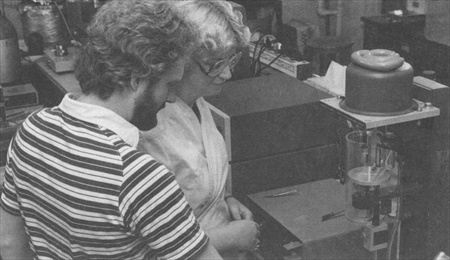
May 1984
John (BS ’84) and Barbara Howell (BS ’82, MS ’85) were very
important contributors to the laboratory in the areas of penetrant
transport in glassy polymers, polymer characterization and solvent
diffusion in coals. Their work led to a better understanding
of penetrant transport of thermodynamically poor solvents in
glassy polymers and macromolecular structures. Through their
work they were able to advance our understanding of Case II
transport.
|
| |
|
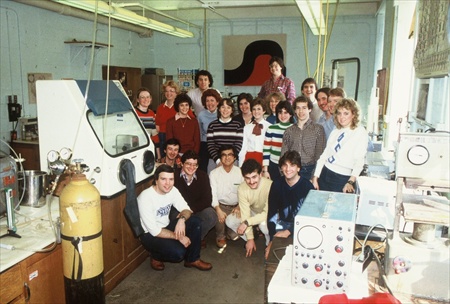
April 1984
Sitting: Don Miller, Serge Segot-Chicq, Phil Ritger, Tae-ho
Kim, Tony Mikos, Ron Harland
Standing: Michelle Smith, Barbara Howell, Sherri Wilson, Joan
Havlin, Julie
Mounts, Cele Latchford, Karen Butler, Jean Meyer, Marcie Getoor,
Randy Haase,
Jim Wiestler, Mike Heglas, Doug Kline, Lori Nelson
Standing on Bench: Steve Lustig, Ray Davidson
|
| |
|
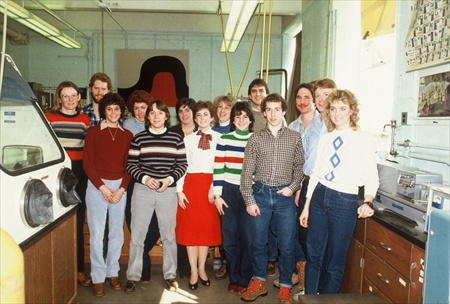
April 1984
Michelle Knight, John Howell, Sherri Wilson, Joan Havlin, Julie
Mounts, Cecilia Latchford, Karen Butler, Jean Meyer, Marcie
Getoor, Jim Wiestler, Randy Haase, Mike Heglas, Doug Kline and
Lori Nelson
|
| |
|
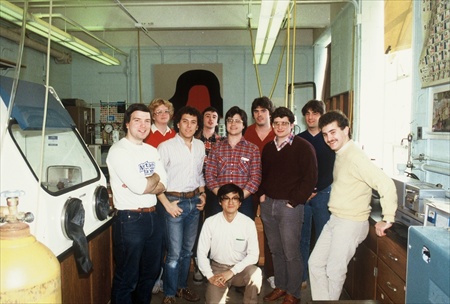
April 1984
Steve Lustig, Barbara Barr-Howell, Steve Lustig, Serge Segot-Chicq,
Rat Davidson, Kent Urdahl, Phil Ritger, Ron Harland, Tony Mikos
and (sitting) Taeho Kim
|
| |
|
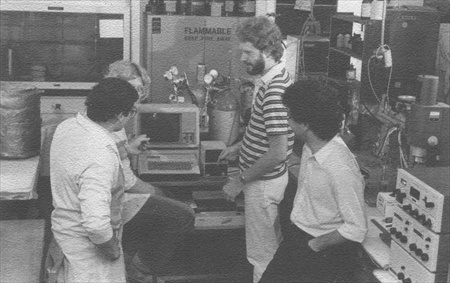
April 1984
Our thermal analysis system (differential scanning calorimeter,
thermomechanical and thermogravimetric analyzers) in our laboratory.
From left: Phil Ritger (MS ’85), Barbara Barr-Howell (MS ’85),
John Howell (BS ’84) and Tony Mikos (MS ’85, PhD ’88). Phil,
Barbara and John were main contributors to the research on the
macromolecular structure of bituminous coals. In those days,
work done by these students as well as Don Hooker, Lucy Lucht,
Mary Beth Hill and, later, Jorge Olivares has a significant
impact not only on coal but also on the molecular analysis of
non-Gaussian networks. Tony Mikos was still doing his MS thesis
on polymerization reaction engineering. It was sin his PhD thesis
that he started working on biomedical problems.
|
| |
|
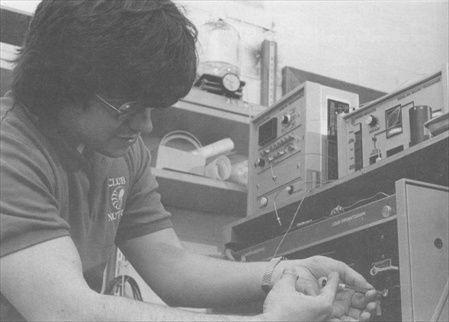
January 1984
Ray Davidson (MS ’82, PhD ’85, now a consultant in Kalamazoo,
MI). Ray was the second student (after Todd Gehr) who worked
on biocompatible polymers. His work applied to the development
of novel artificial kidney membranes.
|
| |
|
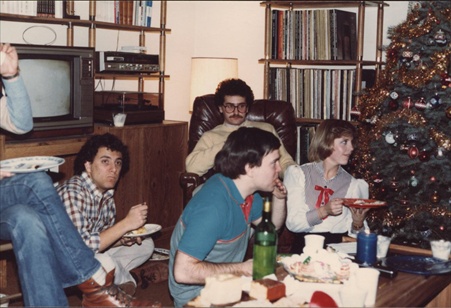
Christmas 1983
Steve Lustig (MS ’85, PhD ’89), Tony Mikos (BS ’85, PhD ’88),
Don Miller (PhD ’84) and Eva Swan (later Eva Swan-Miller, MS
‘81). Steve Lustig is a distinguished senior scientist with
E.I. du Pont deNemours with exceptional research on glassy polymer
behavior. Eva Swan was the first student to analyze the porous
structure of ethylene-vinyl acetate-based drug delivery systems
for protein release. Working in parallel with Ron Siegel (PhD
’83 with Bob Langer at MIT), she established the definitive
models of protein transport from these porous polymers.
|
| |
|
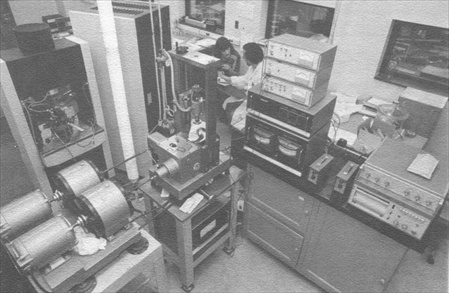
September 1982
Nicholas Peppas in the new polymer rheology laboratory in the
Potter building
|
| |
|
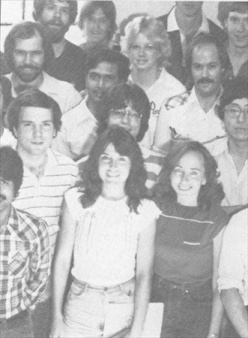
August 1982
Old and new graduate students pose for a picture. Students who
worked in the Peppas labs include: First row from left: Lucy
Hair-Lucht (BS ’78, PhD ’83, now with the Lawrence Livermore
Laboratories in California) and Katy Reinhart-Stutts (MS ’80,
now with Corning in Corning, NY). Second row: Don Miller (PhD
’84, now Director of Oncology at Wyeth) and Ray Davidson (MS
’82, PhD ’85, now a consultant in Kalamazoo, MI). In the middle
of the last row, Barbara Barr-Howell (MS ’84, now with Kimberley-Clark
in Atlanta, GA). Lucy Hair was the researcher who started the
work on the use of macromolecular theories to analyze the swelling
behavior of bituminous coals, as subject that continued until
the very early 1990s with DOE support. Katy Reinhart was the
originator of the Reinhart-Peppas theory of solute diffusion
in hydrogels. Don Miller was a pioneer in protein absorption
studies on hydrogel surfaces, work that led to improved biocompatible
biomaterials. Characteristic of the prevailing climate in chemical
engineering those days is that in 1983, while interviewing with
a major oil company, Don was scolded by their recruiters that
his research was “not chemical engineering”. Don went on to
wok with several pharmaceutical companies. He is now Director
of Oncology at Wyeth. Don was one of the originators of the
Mylotarg® cancer therapy technology and was recognized by the
American Chemical Society with its 2004 Hero of Chemistry award.
The oil company in question does not exist anymore… Ray Davidson
was the second student (after Todd Gehr, MS ‘77) who worked
on biocompatible polymers. His work was applied to the development
of novel artificial kidney membranes. Finally, Barbara Barr-Howell
continued Lucy Lucht’s work in the field of bituminous coals
and developed the earliest work on anomalous transport in coals.
She determined the relaxational importance in the bituminous
coal structure in coal swelling. Barbara is the holder of the
record for most publications from a MS thesis. She published
12 papers!
|
| |
|
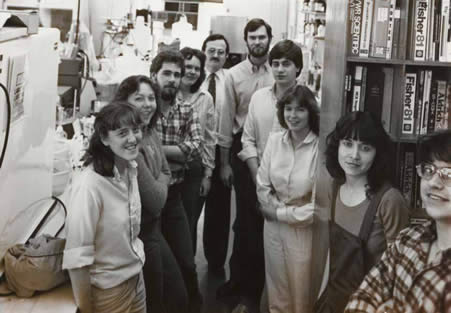
March 1982
Martha Honey (now with duPont in Houston), Donna McCullum-Foster
(now in Akron, OH), Tod Jilg (now with Celanese in Rock Hill,
SC), Nancy Franson (now with Schering-Plough), Nicholas Peppas,
Richard Korsmeyer (now with Pfizer in New London, CT), John
Larson (now with Corning in Corning, NY), Rachel Lenox-Mace
(now Professor of Pediatrics at the School of Medicine of Vanderbilt
University, Nashville, TN), Lucy Hair-Lucht (now with Lawrence
Livermore Laboratories in Livermore, CA), Ray Davidson (now
a consultant in Kalamazoo, MI).
|
| |
|
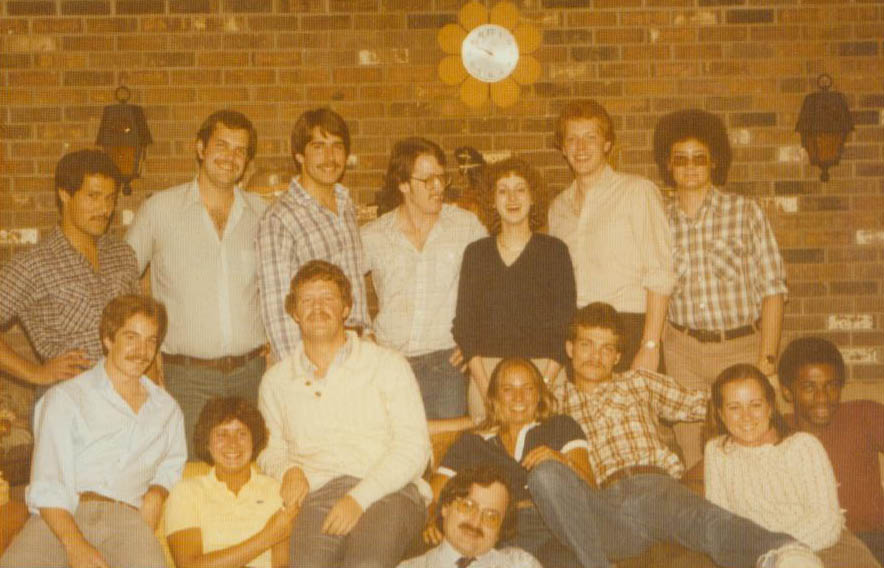
December 1980
Back row: Mark Karrs, Ed Van Hoene, Paul Shafer, Russ Elms,
Kim Evans, Dave Rumsey, Dave Tyler.
Front row: Mark Miles, Jenny Wetzel (now Reinhardt), Mark Cheesman,
Nicholas Peppas,
Teri Carter, Jerry Stacy, Patty Wilson, Charles Wilson
|
| |
|

1980
Eva Swan and Don Miller in 1980. This photograph was used by
Purdue ChE in their early 80s publicity to show the changing
chemical engineering world. Don and Eva work now for Wyeth.
Don Miller was the winner of the 2004 Heroes in Chemistry Award
of the American Chemical Society for his invention and production
of the Mylotarg system for cancer treatment
|
| |
|
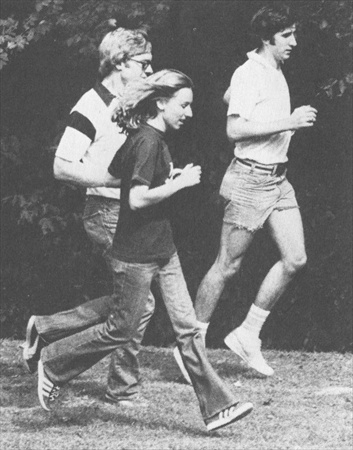
April 1980
Brian Stutts (a PhD student of Professor Henry Lim), Katy Reinhart-Stutts
(MS ’80, now with Corning in Corning, NY) and Mike Cala (a PhD
student of Professors KC Chao and Bob Greenkorn) at the Departmental
picnic.
|
| |
|
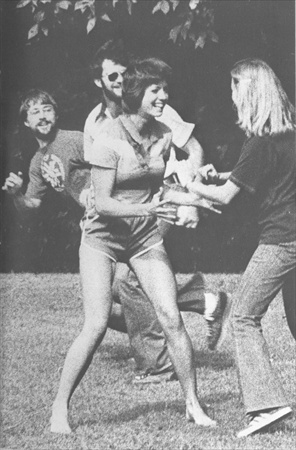
April 1980
Spring picnic. From left: Steve Clark (BS '79, MS '82, PhD '85),
Richard Korsmeyer (MS ’80, PhD ’83, now Global Head of Licensing,
Pfizer, New London, CT), Mary Beth Hill (MS ’91, now with Eastman
Kodak, Rochester, NY) and Katy Reinhart-Stutts (MS ’80, now
with Corning in Corning, NY). Steve Clark was an important contributor
is early membrane research in our labs.
|
|
